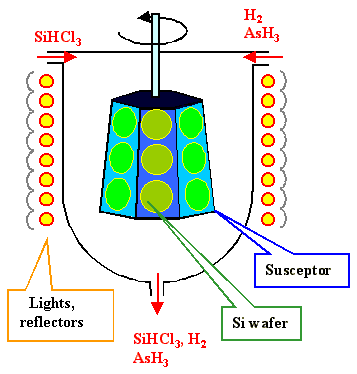
- English
- Español
- Português
- русский
- Français
- 日本語
- Deutsch
- tiếng Việt
- Italiano
- Nederlands
- ภาษาไทย
- Polski
- 한국어
- Svenska
- magyar
- Malay
- বাংলা ভাষার
- Dansk
- Suomi
- हिन्दी
- Pilipino
- Türkçe
- Gaeilge
- العربية
- Indonesia
- Norsk
- تمل
- český
- ελληνικά
- український
- Javanese
- فارسی
- தமிழ்
- తెలుగు
- नेपाली
- Burmese
- български
- ລາວ
- Latine
- Қазақша
- Euskal
- Azərbaycan
- Slovenský jazyk
- Македонски
- Lietuvos
- Eesti Keel
- Română
- Slovenski
- मराठी
- Srpski језик
CVD process for SiC wafer epitaxy
2023-04-19
The CVD process for SiC wafer epitaxy involves the deposition of SiC films onto a SiC substrate using a gas-phase reaction. The SiC precursor gases, typically methyltrichlorosilane (MTS) and ethylene (C2H4), are introduced into a reaction chamber where the SiC substrate is heated to a high temperature (usually between 1400 and 1600 degrees Celsius) under a controlled atmosphere of hydrogen (H2).
During the CVD process, the SiC precursor gases decompose on the SiC substrate, releasing silicon (Si) and carbon (C) atoms, which then recombine to form a SiC film on the substrate surface. The growth rate of the SiC film is typically controlled by adjusting the concentration of the SiC precursor gases, the temperature, and the pressure of the reaction chamber.
One of the advantages of the CVD process for SiC wafer epitaxy is the ability to achieve high-quality SiC films with a high degree of control over film thickness, uniformity, and doping. The CVD process also allows for the deposition of SiC films onto large-area substrates with high reproducibility and scalability, making it a cost-effective technique for industrial-scale manufacturing.

During the CVD process, the SiC precursor gases decompose on the SiC substrate, releasing silicon (Si) and carbon (C) atoms, which then recombine to form a SiC film on the substrate surface. The growth rate of the SiC film is typically controlled by adjusting the concentration of the SiC precursor gases, the temperature, and the pressure of the reaction chamber.
One of the advantages of the CVD process for SiC wafer epitaxy is the ability to achieve high-quality SiC films with a high degree of control over film thickness, uniformity, and doping. The CVD process also allows for the deposition of SiC films onto large-area substrates with high reproducibility and scalability, making it a cost-effective technique for industrial-scale manufacturing.




